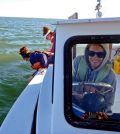Posts for tag "NERR"
Health, Resilience and Stewardship in the Hudson River: Responding to Climate Emergencies
HRNERR is dedicated to improving the health of the Hudson River through education, training, restoration, monitoring, and research programs.
- Posted August 29, 2022
The Center for Coastal Studies: Dedicated To Monitoring the Health of Cape Cod and Nantucket Waters
Massachusetts’ Center for Coastal Studies provides important water quality data for Cape Cod and Nantucket Sound via an array of sophisticated equipment and a group of dedicated researchers and volunteers.
- Posted April 23, 2019
Enchanting Eelgrass: Nine Thousand Acre Eelgrass Meadow Gives Padilla Bay NERR Unique Charm
Picturesque Padilla Bay NERR participates in SWMP monitoring, specialized research in eelgrass environmental monitoring and research focusing on purple sea stars.
- Posted September 27, 2018
From Salmon to SWMP: Kachemak Bay NERR Keeps A Close Eye on Delicate Alaskan Ecosystem
Beautiful Kachemak Bay NERR is full of environmental monitoring opportunities and mountain vistas, a home for many highly-prized species like salmon.
- Posted August 21, 2018
Stripers, Skilletfish and Sondes: Jacques Cousteau NERR Serves Up Vast Research Possibilities
Jacques Cousteau NERR, located in New Jersey, follows the same SWMP protocols as the rest of the nation’s 28 NERRS yet also retains its unique character.
- Posted May 21, 2018
Wild Whooping Cranes and Wide Open Spaces: Mission-Aransas NERR Shows Unique Side of Texas
Mission-Aransas NERR offers some bird watching unparalleled in the U.S. In addition to SWMP monitoring, Mission-Aransas also stays on top of HAB threats.
- Posted May 2, 2018
Beaches, Moths and Reynolds Mansion: Sapelo Island NERR Shows Off Historic Beauty
In addition to SWMP monitoring done by all NERRS, Sapelo Island NERR in Georgia has also been the home of some exceptional Lepidoptera research.
- Posted April 27, 2018
Diamondback Terrapins, Henslow’s Sparrows and Clapper Rails: Environmental Monitoring Is Grand at Grand Bay NERR
Grand Bay NERR in Mississippi provides abundant wildlife and data for an intrepid SWMP Coordinator. But a phosphate factory neighbor poses challenges.
- Posted April 13, 2018
Waquoit Bay NERR Makes It Easy to Explore: Trout, Jellyfish, Rare Plants and More
Waquoit Bay NERR researchers use SWMP protocols, YSI sondes to keep track of the changing bay. Waquoit also boasts the rare New England cottontail rabbit.
- Posted April 9, 2018
Great Catches: Larval Fish, Soft Shell Clams, New eDNA Research Netted at Wells NERR
Wells NERR has undergone many changes, but the unfailing support of local Maine citizens has always remained the same.
- Posted April 6, 2018
Small But Mighty: Tijuana River NERR Makes the Most of Reverse Estuarine System
Tijuana River is not your typical NERR. The place where desert meets ocean meets freshwater is also home to Ridgway’s rails, halibut nurseries and more.
- Posted March 7, 2018
Sea Turtles, Stingrays and Shrimp: Apalachicola NERR’s Coastal Conservancy
Standard SWMP monitoring and special monitoring help to keep tabs on the conditions and creatures of this fascinating, well-cared-for Florida NERR.
- Posted March 5, 2018
From Salamanders to Shorebirds: Environmental Monitoring Adventures at Elkhorn Slough NERR
Elkhorn Slough NERR in California is home to some special salamanders, frogs, shorebirds and more. Volunteers help gather valuable Slough wildlife data.
- Posted February 27, 2018
Weeks Bay NERR offers glimpse into ancient estuaries along the northern Gulf of Mexico
Steeped in history, Weeks Bay NERR offers outdoor enjoyment and critical environmental monitoring. Red mangroves and feral hogs may threaten the area.
- Posted February 21, 2018
Estuarine Invaders: Environmental Monitoring Tracks Lake Superior NERR Non-Native Species, Surveils Water Quality
St. Louis River imbues Lake Superior NERR with its unique character. Monitoring includes SWMP, keeping an eye on purple loosestrife and other issues.
- Posted February 8, 2018
Great Hope for Great Bay: Environmental Monitoring and Instituting Social Change
Environmental monitoring shows that Great Bay has made great recovery since the early days of aggressive logging 100 years ago
- Posted February 5, 2018
ACE Basin NERR Monitoring Showcases Unique Coastal Life
ACE Basin’s short nosed sturgeon, wood storks, loggerhead turtles and other life are monitored regularly; a fleet of sondes provides water quality data.
- Posted January 29, 2018
Even the tiny phytoplankton: Guana Tolomato Matanzas NERR tracks life both large and small
Using a wide variety of technology, Guana Tolomato Matanzas NERR keeps on top of diverse species, including oysters.
- Posted January 26, 2018
Horseshoe Crabs and Red Knots: Delaware NERR Monitoring Offers Glimpse into Coastal Wildlife
Environmental monitoring of Delaware’s National Estuarine Research Reserve reveals a rich harvest of some of nature’s most ancient and remarkable characters.
- Posted December 30, 2017





















